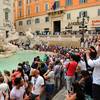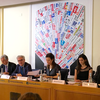Summer in Italy: Time to Celebrate a Sagra
Mid-summer Italy is sagra time, when even the smallest town enjoys celebrating itself and its local identity, especially but not only through its culinary specialties, from wine to chestnuts, cheese, honey and even pumpkins. Visitors are welcome, and many will come as guests in agritourism farmhouses.
The word sagra derives from the Latin word sacrum for "sacred." In antiquity the townspeople gathered together to celebrate, with the foods of the earth, important moments of communal life, with offerings to the gods in recognition of the abundance of a harvest. In Christian times the sagra was generally associated with the feast day of a patron saint and often included a solemn procession. Its religious character survives primarily in the word itself, and most of today's sagre involve foods as well as entertainment and sometimes a fair.
Research shows that today the sagra is ever more popular. A poll conducted by Coldiretti, Italy's foremost national organization of farming with almost 10,000 affililiates, showed that six out of every ten Italians participate in the sagre.
"This is a rediscovery -- the result of people's need to have a more direct relationship with the foods and the cultural traditions of their territory," the Coldiretti pollsters reported. "The lion's share of the events are the typical local and seasonal products, prepared strictly according to custom."
Italy has an abundance of these local products identified with the territory. Wine labels, for instance, boast the territory by carrying three different designations, all guaranteed by strict Italian laws and certified by the European Union. The most rigorous to be found on your wine label -- and there are only a handful of these, the elite of the wine market -- carry the initials DOCG, for Denomination of Origin Controlled and Guaranteed by dint of geographic authenticity. The quality is guaranteed regarding the type of grape, alcohol content and the aging of the wine.
Next on the label listing comes DOC, or Denomination of Origin Controlled, shared by some 505 types of wine. Another 331 Italian wines are recognized as typical of a certain region, and show on the label IGT for Indicazione Geografica Tipica (Typical Geographic Indication). For details, click here.
Besides wines, also certified as regional specialities are 4,606 recognized traditional foods, from hams and sausages to cheeses. DOP or Denominazione di Origine Protetta (Denomination of Protected Origin) is the certified label for such guaranteed regional specialties as Prosciutto crudo San Daniele, or air died prosciutto from San Daniele near Udine, and for Parmigiano Reggiano, produced only in Parma, Reggio Emilia, Modena, Bologna and Mantua.
These are among the types of specialties offered in stands in the local sagre, which now tend to include interesting events as well as the foods. This mid-July, for instance, the town of Canale, near Serino in Avellino, fetes, along with local foods, artists whose works line the narrow streets, piazzas and palazzo courtyards. At Mandas in the mountainous Sardinian Barbagia, the Sagra del formaggio -- a cheese feast -- begins July 16 and continues with local music, dancing, lectures on whither the pastoral culture, guided visits to cheese-making establishments and introductions to other traditional local foodstuffs such as breads,cookies and desserts.
Moving toward the center-north of Italy, from August 10 - 20, the Sagra della Zucca (pumpkin) takes place at San Carlo in Emilia Romagna. A star attraction (and a personal favorite) are the area's fabulous home-made pumpkin-stuffed ravioli.
Near Rome, Allumiere celebrates its Sagra del Cinghiale (wild boar) festival beginning July 7. Also on offer as part of the sagra are tours of the famous local woodland, the Faggeto, where the ancient mines of aluminium sulfate are located. Another Sagra del Cinghiale begins July 7 at Tarquinia, site of the ancient Etruscan city as well as today's modern town. Boar is a typical local dish, popular for a pasta ragù as well as for sausage.
Also north of Rome on July 8 and 9 is Formello's sagra, with folk dancing, a demonstration of acrobatics, games for youngsters, a literary prize award and a parade of locals in Etruscan dress, besides stands with local foods. And at Fabrica di Roma, near Viterba, from July 14 - 16 the Sagra della Pecora (Sheep sagra) takes place. Besides live bands -- marching bands and funky music from the 70s and 80s, demonstrations of the art of making sheeps milk cheese, or pecorino, and ricotta are presented. Needless to say, perhaps, the menu begins with the antipasto del pastore, the shepherd's first course, and ends with a cake made of sheeps milke ricotta and pears.
(For a full rundown of sagre in every Italian region, with dates and details, click here











































i-Italy
Facebook
Google+
This work may not be reproduced, in whole or in part, without prior written permission.
Questo lavoro non può essere riprodotto, in tutto o in parte, senza permesso scritto.